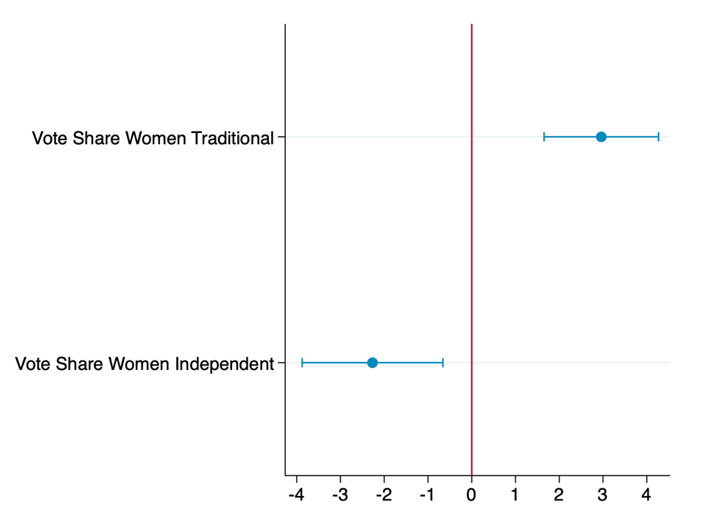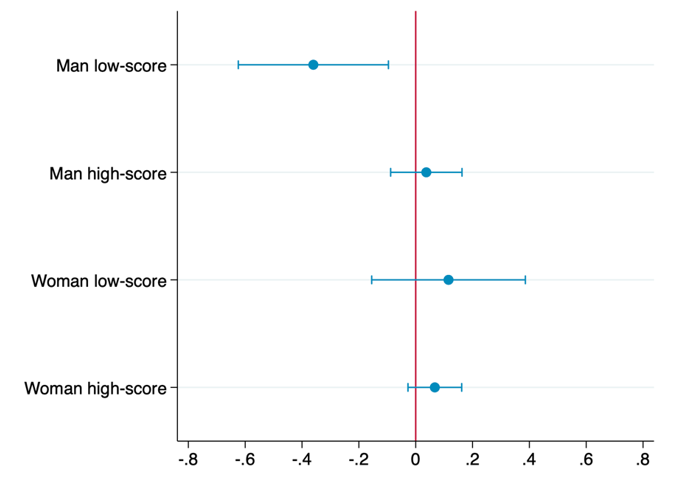
The impacts of a campaign to raise awareness of Chile’s new gender quota show how voters strategically respond to electoral laws
Citizens in representative democracies look for legislators who can represent their opinions and concerns. According to a large body of research, women politicians better represent the policy interests of female voters and are frequently preferred by them (Dolan 1998, Chattopadhyay and Duflo 2004, Schwindt-Bayer 2006, Clots-Figueras 2012, Hessami and Lopes da Fonseca 2020, Schwarz and Coppock 2022). However, even with a large population share and distinctive preferences, it is a persistent fact that women are under-represented in politics. Understanding whether policies can successfully improve female representation, as well as their effects on voters and elected candidates, is a top priority for policymakers around the world.
I studied the election of members of Chile's constitutional convention in May 2021, which was the first election worldwide to require gender parity for candidates and elected officials without restricting voters' gender choice. This novel method allowed voters to vote for a candidate of any gender, but to ensure gender equality, election results were adjusted. To understand how this adjustment works, suppose that in a district of four seats, the most voted candidates were three men and one woman. In that case, the man with the least votes of the three is replaced by the most-voted woman on his same coalition who had not already won a seat in the initial ballot. The result maintains the initial representation of political parties but now with two men and two women elected.
In addition to the gender quota, independent candidates were allowed to run together on a single electoral list of multiple candidates for the first time. This change gave independent candidates—most of whom were first-time nominees—the same opportunity to participate on election lists as candidates from political parties. The inclusion of independent coalitions broadened the ideological and gender distribution of candidates – while traditional political parties were pro-male as measured by the gender gap in candidate campaign contributions and vote share for members of the constitutional convention, the reverse was true for the independent lists.
Because each coalition had a gender gap, the quota changed the probabilities of election for each candidate. Traditional parties that previously had a higher likelihood of electing men now face the possibility that, with the adjustment, female candidates would replace their male candidates. Therefore, the gender quota in pro-male coalitions increased the likelihood of women being elected. The opposite is true in pro-female coalitions, where women were more likely to be elected than men.
Understanding the impact of this gender quota on voters helps to provide evidence for designing better rules that can increase the representation of women. Do citizens change their voting behaviour in the face of a mandate altering elected representatives' identity, and if so, how does this affect the competence of politicians?
A week before the election, a campaign to inform voters about the gender quota was launched
To understand how the gender quota affected voters' choices, I carried out a randomised information campaign (Paredes-Haz 2023). The campaign consisted of a letter sent a week before the election, in partnership with the United Nations Development Programme (UNDP), explaining how the gender quota worked. Awareness of the new quota was expected to not be universal, as suggested by several surveys, so the information campaign meaningfully increased the treated individuals’ understanding of the quota’s likely effects. Because voters are assigned to specific booths in advance of the election, I was able to randomise the intervention and study its effects at the voting booth level, the finest level at which election results are made public. By using administrative data on voting outcomes, I provide causal evidence of voters' strategic behaviour in the presence of a gender quota without relying on self-reported data.
Figure 1: Voting booth

The knowledge about the gender quota altered the voters' choice of candidates
My experiment tested the hypothesis that when informed about the gender quota, citizens change their strategic gender selections because their expectations for candidates’ eligibility changes. Consistent with the nature of strategic behaviour, voters of independent coalitions (female-favouring) reduced their votes for women by two percentage points when provided with information on the quota. In comparison, voters of traditional coalitions (male-favouring) increase their support for women by three percentage points.
These results support the hypothesis that voters consider election probabilities when making their voting decision, as treated voters are more likely to choose candidates that increase their probability of getting elected in their coalition due to the gender quota.
Figure 2: Vote share for women by coalition

When voters change their vote, they vote for more competent candidates
Given that the findings indicate that voters consider the probabilities of candidates being elected, the natural follow-up question is which types of candidates voters move away from and which candidates they support more when gender quotas are implemented. I focus on a candidate's ability as proxied by their test scores for college admissions. This proxy has been used because of the positive correlation with other political efficiency outcomes, such as citizen satisfaction and local public finance outcomes (Besley et al. 2017).
For the traditional parties, the treatment reduces the vote share of male candidates with low test scores and has a zero effect on men with high test scores. The intervention has no differential effect by quality for female candidates in the traditional groups. For the independent group, the results indicate no differential effect by quality for any gender.
The findings for the traditional group are consistent with previous research (Besley et al. 2017), and show that the information campaign does not change the ability of elected women, while leading to increases men's competence for traditional parties, as proxied by college admission test scores.
Figure 3: Vote share for candidates of Traditional Coalitions

Women vote differently from men when they are elected
Lastly, I examine how elected officials voted at the constitutional convention. According to bill-level data on the votes of elected members on constitutional articles, female legislators were more likely to vote in support of social issues, including for topics on women’s rights like abortion and domestic abuse. However, there are no gender-based voting discrepancies for economic and administrative bills. These results are consistent with past research arguing that women implement different policies than men.
Closing thoughts: What did we learn about the Chilean experience?
This analysis indicates that informed voters differentially choose to vote for candidates of the gender expected to benefit most from the quota. Furthermore, the treatment influences people to change their votes based on a candidate's competence, which raises the skill of elected male politicians from traditional parties.
Overall, these findings support the use of electoral mandates as a coordinating device that, when well-designed, can increase the average legislator's competence and the extent to which policy-making processes reflect voter preferences.
References
Besley, T, O Folke, T Persson, and J Rickne (2017), "Gender quotas and the crisis of the mediocre man: Theory and evidence from Sweden", American Economic Review, 107: 2204–42.
Chattopadhyay, R and E Duflo (2004), "Women as policy makers: Evidence from a randomized policy experiment in India", Econometrica, 72(5): 1409–1443.
Clots-Figueras, I (2012), "Are female leaders good for education? Evidence from India", American Economic Journal: Applied Economics, 4(1): 212–44.
Dolan, K (1998), "Voting for women in the 'year of the woman'", American Journal of Political Science, 42(1): 272–293.
Dynarski, S, C Libassi, K Michelmore, and S Owen (2021), "Closing the gap: The effect of reducing complexity and uncertainty in college pricing on the choices of low-income students", American Economic Review, 111(6): 1721–56.
Hessami, Z and M Lopes da Fonseca (2020), "Female political representation and substantive effects on policies: A literature review", European Journal of Political Economy.
Paredes-Haz, A (2023), "Gender quotas and strategic voters: Experimental evidence from Chile’s constitutional convention", Unpublished manuscript.
Schwarz, S and A Coppock (2022), "What have we learned about gender from candidate choice experiments? A meta-analysis of sixty-seven factorial survey experiments", The Journal of Politics, 84(2): 655–668.
Schwindt-Bayer, L A (2006), "Still supermadres? Gender and the policy priorities of Latin American legislators", American Journal of Political Science, 50(3): 570–585.

